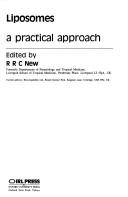| Listing 1 - 7 of 7 |
Sort by
|
Periodical
ISSN: 15322394 08982104 Publisher: New York (N.Y.) : Dekker,
Abstract | Keywords | Export | Availability | Bookmark
 Loading...
Loading...Choose an application
- Reference Manager
- EndNote
- RefWorks (Direct export to RefWorks)
Liposomes --- Liposomes, Ultra-deformable --- Niosomes --- Transferosomes --- Ultradeformable Liposomes --- Liposome --- Liposome, Ultra-deformable --- Liposome, Ultradeformable --- Liposomes, Ultra deformable --- Liposomes, Ultradeformable --- Niosome --- Transferosome --- Ultra-deformable Liposome --- Ultra-deformable Liposomes --- Ultradeformable Liposome --- Phospholipid vesicles --- Lipid Bilayers --- Bilayer lipid membranes --- Cytoplasm --- Phospholipids --- Biochemistry --- Biology --- Biophysics --- Chemistry. --- Cytology, Cell Biology. --- Physical Chemistry --- Life Sciences. --- Chemistry --- Health Sciences --- Life Sciences --- Pharmacy and Pharmacology --- Cytology, Cell Biology --- Liposomes.

ISBN: 0199630771 0199630763 9780199630769 9780199630776 1852210591 9781852210595 1852210605 9781852210601 Year: 1992 Publisher: Oxford : IRL press,
Abstract | Keywords | Export | Availability | Bookmark
 Loading...
Loading...Choose an application
- Reference Manager
- EndNote
- RefWorks (Direct export to RefWorks)
Liposomes. --- Liposomes, Ultra-deformable --- Niosomes --- Transferosomes --- Ultradeformable Liposomes --- Liposome --- Liposome, Ultra-deformable --- Liposome, Ultradeformable --- Liposomes, Ultra deformable --- Liposomes, Ultradeformable --- Niosome --- Transferosome --- Ultra-deformable Liposome --- Ultra-deformable Liposomes --- Ultradeformable Liposome --- Lipid Bilayers --- Liposomes --- Liposomen --- Phospholipid vesicles --- Bilayer lipid membranes --- Cytoplasm --- Phospholipids --- Handbooks, manuals, etc --- Handbooks, manuals, etc. --- Liposomes - Handbooks, manuals, etc
Book
Year: 2020 Publisher: Basel, Switzerland MDPI - Multidisciplinary Digital Publishing Institute
Abstract | Keywords | Export | Availability | Bookmark
 Loading...
Loading...Choose an application
- Reference Manager
- EndNote
- RefWorks (Direct export to RefWorks)
Even in ancient times, semi-solid preparations for cutaneous application, popularly known as ointments, played an important role in human society. An advanced scientific investigation of “ointments” as dosage forms was initiated in the 1950s. It was only from then on that the intensive physico-chemical characterization of ointments as well as the inclusion of dermatological aspects led to a comprehensive understanding of the various interactions between the vehicle, the active ingredient and the skin. From then on, many researchers were involved in optimizing semi-solid formulations with respect to continuously changing therapeutic and patient needs. Aspects that have been dealt with were the optimization of dermato-biopharmaceutical properties and many different issues related to patient compliance, such as skin tolerance, applicability, and cosmetic appeal. Moreover, processing technology has been improved and analytical techniques were developed and refined in order to enable the improved characterization of the formulation itself as well as its interaction with the skin. This Special Issue serves to highlight and capture the contemporary progress and current research on semi-solid formulations as dermal drug delivery systems. We invite articles on all aspects of semi-solid formulations, highlighting the research currently undertaken to improve and better understand these complex drug delivery systems with respect to their formulation, processing and characterization issues.
Medicine --- dermal drug delivery --- diffusion cell --- Franz diffusion --- Skin-PAMPA --- Strat-M® membrane --- nanocarrier --- nonivamide --- methyl cellulose --- skin penetration --- substantivity --- thermogel --- tacrolimus formulation --- nanogels --- drug delivery --- human excised skin --- Jurkat cells --- in situ hydrogel-forming powder --- nitric oxide-releasing formulation --- S-nitrosoglutathione (GSNO) --- antibacterial --- wound dressing --- wound healing --- dermal delivery --- porcine skin --- in vitro permeation --- methadone --- pain --- in vitro --- permeation --- niacinamide --- solvent --- PAMPA --- skin --- curcumin --- deformable liposomes --- liposome surface charge --- hydrogel --- chitosan --- wound therapy --- IVRT --- metronidazole --- topical cream --- semisolid dosage forms --- sameness --- FDA’s SUPAC-SS guidance --- acceptance criteria --- positive and negative controls --- discriminatory ability --- Amphotericin B --- Sepigel 305® --- Leishmania infantum --- cutaneous leishmaniasis --- topical treatment --- birch bark extract --- oleogels --- hydrogen bonding --- triterpene --- rheology --- gel strength --- eosinophilic esophagitis --- budesonide --- xanthan gum --- guar gum --- mucoadhesion --- esophagus permeability --- rheological characterization --- pediatric medicine --- compounded preparation --- non-ionic emulsifiers --- intercellular lipids --- confocal Raman spectroscopy (CRS) --- polyethylene glycol alkyl ethers --- polyethylene glycol sorbitan fatty acid esters --- n/a --- FDA's SUPAC-SS guidance
Book
Year: 2020 Publisher: Basel, Switzerland MDPI - Multidisciplinary Digital Publishing Institute
Abstract | Keywords | Export | Availability | Bookmark
 Loading...
Loading...Choose an application
- Reference Manager
- EndNote
- RefWorks (Direct export to RefWorks)
Even in ancient times, semi-solid preparations for cutaneous application, popularly known as ointments, played an important role in human society. An advanced scientific investigation of “ointments” as dosage forms was initiated in the 1950s. It was only from then on that the intensive physico-chemical characterization of ointments as well as the inclusion of dermatological aspects led to a comprehensive understanding of the various interactions between the vehicle, the active ingredient and the skin. From then on, many researchers were involved in optimizing semi-solid formulations with respect to continuously changing therapeutic and patient needs. Aspects that have been dealt with were the optimization of dermato-biopharmaceutical properties and many different issues related to patient compliance, such as skin tolerance, applicability, and cosmetic appeal. Moreover, processing technology has been improved and analytical techniques were developed and refined in order to enable the improved characterization of the formulation itself as well as its interaction with the skin. This Special Issue serves to highlight and capture the contemporary progress and current research on semi-solid formulations as dermal drug delivery systems. We invite articles on all aspects of semi-solid formulations, highlighting the research currently undertaken to improve and better understand these complex drug delivery systems with respect to their formulation, processing and characterization issues.
dermal drug delivery --- diffusion cell --- Franz diffusion --- Skin-PAMPA --- Strat-M® membrane --- nanocarrier --- nonivamide --- methyl cellulose --- skin penetration --- substantivity --- thermogel --- tacrolimus formulation --- nanogels --- drug delivery --- human excised skin --- Jurkat cells --- in situ hydrogel-forming powder --- nitric oxide-releasing formulation --- S-nitrosoglutathione (GSNO) --- antibacterial --- wound dressing --- wound healing --- dermal delivery --- porcine skin --- in vitro permeation --- methadone --- pain --- in vitro --- permeation --- niacinamide --- solvent --- PAMPA --- skin --- curcumin --- deformable liposomes --- liposome surface charge --- hydrogel --- chitosan --- wound therapy --- IVRT --- metronidazole --- topical cream --- semisolid dosage forms --- sameness --- FDA’s SUPAC-SS guidance --- acceptance criteria --- positive and negative controls --- discriminatory ability --- Amphotericin B --- Sepigel 305® --- Leishmania infantum --- cutaneous leishmaniasis --- topical treatment --- birch bark extract --- oleogels --- hydrogen bonding --- triterpene --- rheology --- gel strength --- eosinophilic esophagitis --- budesonide --- xanthan gum --- guar gum --- mucoadhesion --- esophagus permeability --- rheological characterization --- pediatric medicine --- compounded preparation --- non-ionic emulsifiers --- intercellular lipids --- confocal Raman spectroscopy (CRS) --- polyethylene glycol alkyl ethers --- polyethylene glycol sorbitan fatty acid esters --- n/a --- FDA's SUPAC-SS guidance
Book
Year: 2020 Publisher: Basel, Switzerland MDPI - Multidisciplinary Digital Publishing Institute
Abstract | Keywords | Export | Availability | Bookmark
 Loading...
Loading...Choose an application
- Reference Manager
- EndNote
- RefWorks (Direct export to RefWorks)
Even in ancient times, semi-solid preparations for cutaneous application, popularly known as ointments, played an important role in human society. An advanced scientific investigation of “ointments” as dosage forms was initiated in the 1950s. It was only from then on that the intensive physico-chemical characterization of ointments as well as the inclusion of dermatological aspects led to a comprehensive understanding of the various interactions between the vehicle, the active ingredient and the skin. From then on, many researchers were involved in optimizing semi-solid formulations with respect to continuously changing therapeutic and patient needs. Aspects that have been dealt with were the optimization of dermato-biopharmaceutical properties and many different issues related to patient compliance, such as skin tolerance, applicability, and cosmetic appeal. Moreover, processing technology has been improved and analytical techniques were developed and refined in order to enable the improved characterization of the formulation itself as well as its interaction with the skin. This Special Issue serves to highlight and capture the contemporary progress and current research on semi-solid formulations as dermal drug delivery systems. We invite articles on all aspects of semi-solid formulations, highlighting the research currently undertaken to improve and better understand these complex drug delivery systems with respect to their formulation, processing and characterization issues.
Medicine --- dermal drug delivery --- diffusion cell --- Franz diffusion --- Skin-PAMPA --- Strat-M® membrane --- nanocarrier --- nonivamide --- methyl cellulose --- skin penetration --- substantivity --- thermogel --- tacrolimus formulation --- nanogels --- drug delivery --- human excised skin --- Jurkat cells --- in situ hydrogel-forming powder --- nitric oxide-releasing formulation --- S-nitrosoglutathione (GSNO) --- antibacterial --- wound dressing --- wound healing --- dermal delivery --- porcine skin --- in vitro permeation --- methadone --- pain --- in vitro --- permeation --- niacinamide --- solvent --- PAMPA --- skin --- curcumin --- deformable liposomes --- liposome surface charge --- hydrogel --- chitosan --- wound therapy --- IVRT --- metronidazole --- topical cream --- semisolid dosage forms --- sameness --- FDA's SUPAC-SS guidance --- acceptance criteria --- positive and negative controls --- discriminatory ability --- Amphotericin B --- Sepigel 305® --- Leishmania infantum --- cutaneous leishmaniasis --- topical treatment --- birch bark extract --- oleogels --- hydrogen bonding --- triterpene --- rheology --- gel strength --- eosinophilic esophagitis --- budesonide --- xanthan gum --- guar gum --- mucoadhesion --- esophagus permeability --- rheological characterization --- pediatric medicine --- compounded preparation --- non-ionic emulsifiers --- intercellular lipids --- confocal Raman spectroscopy (CRS) --- polyethylene glycol alkyl ethers --- polyethylene glycol sorbitan fatty acid esters

ISBN: 030641001X 1468442430 1468442414 Year: 1982 Volume: v.47 Publisher: New York London Plenum Press
Abstract | Keywords | Export | Availability | Bookmark
 Loading...
Loading...Choose an application
- Reference Manager
- EndNote
- RefWorks (Direct export to RefWorks)
Drug carriers (Pharmacy) --- Excipients --- Pharmaceutical Preparations. --- Liposomes. --- Macromolecular Substances. --- Pharmaceutical Vehicles. --- -Drug targeting --- -Drugs --- -Liposomes --- -Phospholipid vesicles --- Bilayer lipid membranes --- Cytoplasm --- Phospholipids --- Medicaments --- Medications --- Medicine (Drugs) --- Medicines (Drugs) --- Pharmaceuticals --- Prescription drugs --- Bioactive compounds --- Medical supplies --- Pharmacopoeias --- Chemotherapy --- Materia medica --- Pharmacology --- Pharmacy --- Drugs --- Site-specific drug delivery --- Targeting of drugs --- Target organs (Anatomy) --- Carriers, Drug (Pharmacy) --- Drug carrier systems (Pharmacy) --- Drug vehicles (Pharmacy) --- Vehicles, Drug (Pharmacy) --- Drug delivery systems --- Pharmaceutical Vehicle --- Vehicle, Pharmaceutical --- Vehicles, Pharmaceutical --- Macromolecular Complexes --- Macromolecular Compounds --- Macromolecular Compounds and Complexes --- Complexes, Macromolecular --- Compounds, Macromolecular --- Substances, Macromolecular --- Nanostructures --- Liposomes, Ultra-deformable --- Niosomes --- Transferosomes --- Ultradeformable Liposomes --- Liposome --- Liposome, Ultra-deformable --- Liposome, Ultradeformable --- Liposomes, Ultra deformable --- Liposomes, Ultradeformable --- Niosome --- Transferosome --- Ultra-deformable Liposome --- Ultra-deformable Liposomes --- Ultradeformable Liposome --- Lipid Bilayers --- Pharmaceutic Preparations --- Pharmaceutical Products --- Preparations, Pharmaceutical --- Preparations, Pharmaceutic --- Products, Pharmaceutical --- Drug Dosage Calculations --- Congresses --- Effectivness --- -Congresses --- Targeting --- Dosage forms --- Carriers --- Vehicles --- Drug targeting --- Liposomes --- Macromolecular Substances --- Pharmaceutical Preparations --- Pharmaceutical Vehicles --- Phospholipid vesicles --- Effectiveness&delete& --- Drug --- Pharmaceutical --- Pharmaceutical Preparation --- Pharmaceutical Product --- Preparation, Pharmaceutical --- Product, Pharmaceutical --- Effectiveness --- Cells. --- Cells --- Particles --- Pharmaceutical preparations --- Polymers

ISSN: 00766879 ISBN: 0121827925 9786611020392 1281020397 0080522610 9780123749697 0121822702 0121822753 0121822761 0121827968 9780123813794 9786611011413 128101141X 0080497128 9786611011406 1281011401 008049711X 9786611011376 1281011371 008049708X 9786610633388 1280633387 0080457436 9780121827922 9780121822767 9780121822750 0123749697 9780121827960 9780121822705 Year: 2003 Volume: Volume 372 Publisher: San Diego ; London : Elsevier Academic Press,
Abstract | Keywords | Export | Availability | Bookmark
 Loading...
Loading...Choose an application
- Reference Manager
- EndNote
- RefWorks (Direct export to RefWorks)
Liposomes are cellular structures made up of lipid molecules. Important as a cellular model in the study of basic biology, liposomes are also used in clinical applications such as drug delivery and virus studies.* Liposomes in Biochemistry* Liposomes in Molecular Cell Biology* Liposomes in Molecular Virology
Enzymology. --- Liposomes -- Handbooks, manuals, etc. --- Liposomes. --- Animal Biochemistry --- Cytology --- Biology --- Human Anatomy & Physiology --- Health & Biological Sciences --- Liposomes --- Phospholipid vesicles --- Membranes, Artificial --- Drug Carriers --- Biomedical and Dental Materials --- Biomimetic Materials --- Manufactured Materials --- Specialty Uses of Chemicals --- Specialty Chemicals and Products --- Manufactured Material --- Material, Manufactured --- Materials, Manufactured --- Biomimicry Devices --- Biomimicry Materials --- Biomimetic Devices --- Biomimetic Device --- Biomimetic Material --- Biomimicry Device --- Biomimicry Material --- Device, Biomimetic --- Device, Biomimicry --- Devices, Biomimetic --- Devices, Biomimicry --- Material, Biomimetic --- Material, Biomimicry --- Materials, Biomimetic --- Materials, Biomimicry --- Drug Carrier --- Artificial Membranes --- Artificial Membrane --- Membrane, Artificial --- Bilayer lipid membranes --- Cytoplasm --- Phospholipids --- Biochemistry --- Enzymes --- Dosage Forms --- Pharmaceutical Preparations --- Chemicals and Drugs --- Technology, Industry, and Agriculture --- Chemical Actions and Uses --- Technology, Industry, Agriculture --- Pharmaceutic Preparations --- Pharmaceutical Products --- Pharmaceuticals --- Preparations, Pharmaceutical --- Drugs --- Preparations, Pharmaceutic --- Products, Pharmaceutical --- Pharmacology --- Drug Dosage Calculations --- Biocompatible Materials --- Dosage Form --- Form, Dosage --- Forms, Dosage --- Drug Administration Routes --- Drug Delivery Systems --- Liposomes, Ultra-deformable --- Niosomes --- Transferosomes --- Ultradeformable Liposomes --- Liposome --- Liposome, Ultra-deformable --- Liposome, Ultradeformable --- Liposomes, Ultra deformable --- Liposomes, Ultradeformable --- Niosome --- Transferosome --- Ultra-deformable Liposome --- Ultra-deformable Liposomes --- Ultradeformable Liposome --- Lipid Bilayers --- Drug --- Pharmaceutical --- Pharmaceutical Preparation --- Pharmaceutical Product --- Preparation, Pharmaceutical --- Product, Pharmaceutical --- Magnetic Iron Oxide Nanoparticles
| Listing 1 - 7 of 7 |
Sort by
|

 Search
Search Feedback
Feedback About UniCat
About UniCat  Help
Help News
News